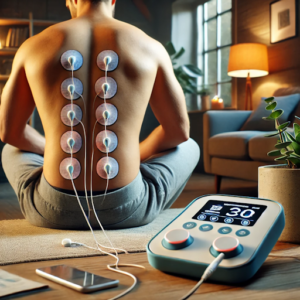Effectively Managing Back Pain Through Electrotherapy
Back pain is a widespread issue affecting millions worldwide, transcending age, gender, and lifestyle factors. It can manifest in various ways, from sharp discomfort lasting a few days to chronic pain that persists for months or years. Often, back pain stems from a combination of physical, psychological, and environmental factors.
Common causes of back pain include muscle strain, herniated discs, arthritis, and poor posture. The variability in how back pain is experienced complicates diagnosis and treatment. While some may find the pain tolerable, others could be severely debilitated, requiring a comprehensive approach from healthcare professionals.
Beyond physical health, chronic back pain can take a toll on emotional well-being, often leading to anxiety, depression, and social isolation. The economic implications are substantial, as back pain is one of the leading causes of disability and reduced productivity in workplaces.
Understanding the underlying causes of back pain is crucial for developing effective treatment strategies. One such strategy is electrotherapy, which has gained recognition for its ability to relieve pain and promote recovery.
Summary
- Back pain may result from factors like poor posture, muscle strain, or injury and significantly impact daily life.
- Electrotherapy is a non-invasive technique that uses electrical energy to manage pain and promote healing.
- Electrotherapy offers pain relief, muscle relaxation, improved circulation, and reduced inflammation.
- Different electrotherapy methods like TENS and EMS can help alleviate back pain.
- When using electrotherapy, it's important to follow healthcare professional advice and avoid using it near the heart or on broken skin.
 Introduction to Electrotherapy
Introduction to Electrotherapy
Electrotherapy refers to various techniques that use electrical energy to treat conditions like back pain. This therapeutic approach has evolved, utilizing advanced technologies to offer pain relief and promote healing. Electrotherapy can target specific areas of discomfort by stimulating nerves and muscles through electrical impulses.
Unlike medications, which may cause side effects or dependency, electrotherapy is non-invasive and effective in managing back pain. As research continues, the benefits of electrotherapy are becoming more widely recognized, leading to its integration into comprehensive pain management plans.
Benefits of Electrotherapy for Back Pain
One of the primary benefits of electrotherapy is its ability to provide immediate pain relief. Elect electrotherapy interrupts pain signals by sending electrical impulses to the affected area, reducing discomfort.
Additionally, it promotes the release of endorphins, the body's natural pain relievers, further enhancing its effectiveness. Electrotherapy also improves blood circulation and reduces inflammation, supporting the healing process. This combination of immediate and long-term benefits makes electrotherapy a valuable tool for managing back pain.
Types of Electrotherapy for Back Pain
Electrotherapy encompasses various methods, each targeting different aspects of back pain management. TENS (Transcutaneous Electrical Nerve Stimulation) is a popular technique that delivers low-voltage electrical currents to relieve pain. Its portability and ease of use make it ideal for home treatment.
IFC (Interferential Current Therapy) uses medium-frequency electrical currents to reach deeper tissues and address musculoskeletal issues. Additionally, EMS (Electrical Muscle Stimulation) and microcurrent therapy are increasingly recognized for stimulating muscle contractions and aiding tissue repair.
 How to Use Electrotherapy for Back Pain Management
How to Use Electrotherapy for Back Pain Management
Following specific guidelines is crucial to ensuring safety and effectiveness when using electrotherapy. Patients should consult a healthcare provider to determine the best electrotherapy option. Once a treatment plan is in place, therapy can be administered in a clinical setting or with portable devices at home.
Home users must follow the manufacturer's instructions for electrode placement, intensity, and session duration. A typical session lasts between 20 and 60 minutes. Consistency is key, as regular treatments offer cumulative benefits over time. Regular communication with a healthcare provider is essential to track progress and make adjustments if needed.
Precautions and Considerations When Using Electrotherapy
Although electrotherapy is generally safe, certain precautions should be taken to avoid complications. Individuals with heart disease, epilepsy, or implanted devices like pacemakers should consult a healthcare provider before using electrotherapy. Pregnant women are also advised to avoid electrotherapy near the abdomen or lower back.
It is important to avoid placing electrodes on open wounds or infected areas. Patients should also monitor their bodies for adverse reactions during treatment and stop immediately if they experience increased pain or skin irritation.
 Integrating Electrotherapy with Other Back Pain Management Techniques
Integrating Electrotherapy with Other Back Pain Management Techniques
Integrating electrotherapy with other treatments can enhance back pain management. A holistic approach often yields better results than relying on a single therapy. Combining electrotherapy with physical therapy can strengthen muscles and improve flexibility while addressing underlying musculoskeletal problems.
Making ergonomic adjustments at work or home can further enhance the benefits of electrotherapy by reducing strain on the back. Additionally, incorporating stress-reducing practices like yoga or meditation can help alleviate pain perception by promoting relaxation.
FAQs
Can you tell me about electrotherapy for back pain?
Electrotherapy uses electrical stimulation to manage and relieve back pain—standard methods in inStandardTENS and EMS.
How might electrotherapy help with my back pain?
Electrotherapy stimulates nerves and muscles to improve blood flow, promote healing, block pain signals, and trigger the production of endorphins, the body's natural painkillers.
Is it safe to use electrotherapy for back pain?
Electrotherapy is generally safe when guided by a trained healthcare provider. Follow recommended protocols and avoid applying the device near the head or heart.
How does electrotherapy work for back pain?
Electrotherapy relieves pain, reduces muscle spasms, and improves flexibility. It's a non-invasive and drug-free option for managing back pain.
Who can benefit from electrotherapy for back pain?
Electrotherapy may benefit individuals with conditions such as strained muscles, arthritis, sciatica, or herniated discs as part of a broader pain management strategy.
Are there any situations where electrotherapy isn't recommended?
Electrotherapy is not recommended for individuals with pacemakers, epilepsy, or heart conditions. Consult a doctor before starting treatment.
Brought To You By: Back Pain Therapy
The Article: Managing Back Pain with Electrotherapy appeared first on https://mcrtherapies.co.uk
The Article Managing Back Pain with Electrotherapy appeared first on https://mcrtherapies.com
The Article Managing Back Pain with Electrotherapy Was Found On https://limitsofstrategy.com


This is such an important topic, and it truly resonates with me. I’ve dealt with back pain off and on for years, stemming from both an active lifestyle and some less-than-ideal habits like hunching over my laptop for long stretches. What really struck me in your post is how back pain isn’t just a physical issue—its emotional and social toll is often overlooked.
This is such an important topic, and it truly resonates with me. I’ve dealt with back pain off and on for years, stemming from both an active lifestyle and some less-than-ideal habits like hunching over my laptop for long stretches. What really struck me in your post is how back pain isn’t just a physical issue—its emotional and social toll is often overlooked.
It’s interesting how back pain can be such a multifaceted issue. I can relate to your experience, especially with the struggles of maintaining good posture while working on a laptop for long hours. It often feels like a juggling act between staying active and managing the wear and tear on our bodies.
I completely agree with you about the complexity of back pain. It’s like it has so many layers, and our daily habits often contribute to it more than we realize. I’ve found that working from home has really highlighted the struggle of maintaining good posture while glued to my laptop. Some days, I notice I’m slouching, and it takes a conscious effort to correct it.
This blog post touches on a topic that resonates with many of us, given how pervasive back pain is in our lives today. I can definitely relate to the multifaceted nature of this issue. As someone who has experienced chronic back pain for years, I found that understanding the root causes was pivotal for managing my situation effectively. It’s fascinating how our lifestyles—involving prolonged sitting, less physical activity, and even the mental stressors we face—contribute to issues like muscle strain or poor posture.
It’s interesting how back pain can serve as a reflection of so much more than just a physical issue—it really highlights the interplay between our daily habits and overall well-being. I can relate to your experience of exploring the root causes; it often feels like a puzzle that requires both patience and a bit of self-discovery.
It’s really refreshing to hear your perspective on how back pain goes beyond just the physical. It takes so much more than just addressing the discomfort; it’s like peeling back layers to uncover habits and lifestyle patterns we may not even realize are contributing factors. Sometimes, it feels like we’re detectives in our own lives, trying to connect the dots between what we do daily and how it impacts our bodies.
“I’m glad you found that perspective resonant! If you’re interested in diving deeper into the connections between habits and well-being, I invite you to explore more insights here.”
https://forgottenportal.com/lifeguard
This topic resonates deeply with me, as I have personally navigated the complexities of back pain for several years. It’s striking how multifaceted back pain can be—not only physically but also emotionally. For instance, I’ve noticed that days when my pain is at its peak, it often amplifies feelings of anxiety and isolation. It’s a harsh reminder of how intertwined our mental and physical health is.
I completely relate to what you’re saying about the emotional aspects of back pain. It’s interesting how our bodies and minds are so interconnected. On tough days, I’ve found that the frustration of physical discomfort can really amplify feelings of stress and even loneliness. It’s almost like the pain becomes a filter, coloring everything else we experience.
I get where you’re coming from. Back pain really does have this way of creeping into every corner of life, doesn’t it? What often surprises people is that the toll it takes isn’t just about the physical. You mentioned anxiety and isolation, and that connection is something many don’t fully grasp until they’ve experienced it firsthand.
“Thank you for sharing your experience; it’s a powerful reminder of that connection between mind and body. If you’re looking for additional support, I encourage you to explore this resource that offers strategies for managing both physical and emotional aspects of back pain.”
https://forgottenportal.com/lifeguard
You’ve raised some crucial points about the multifaceted nature of back pain and the impact it can have on individuals’ lives. It’s interesting to note how back pain not only affects physical health but also interweaves into emotional and social dimensions. As someone who has dealt with chronic back issues for several years, I can attest to the compounded effects you mentioned.
This is such an important topic! Having struggled with back pain myself, I truly appreciate how it can affect not just physical health but overall quality of life. I’ve found that combining electrotherapy with some mindfulness practices really helps in managing both the pain and the emotional toll it can take. It’s fascinating how interconnected our physical and mental health is—when I focus on relaxing my mind, I notice a notable reduction in my discomfort.